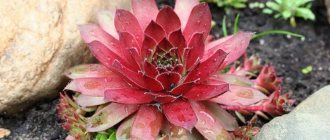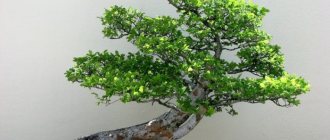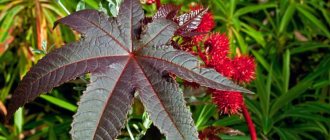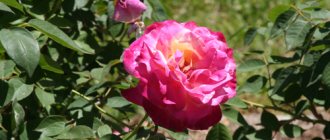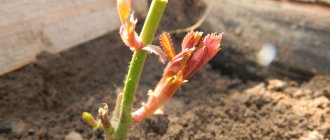The botanical genus Juvenile, called by its Latin name Sempervivum, literally means “ever living.” These evergreen succulents are among the hardiest garden plants and grow well even in harsh climates. In addition to durability, they win the hearts of gardeners with their unusual appearance and impressive color range. In this article we will tell you how to grow young - planting and care in the open ground, show photos of varieties, how to propagate it, where is the best place to plant it.
Description: varieties and varieties of young
Anyone who has never seen a young fish, but has heard any of its names, will certainly want to look at this miracle of nature.
If not live, then at least in the photo. The plant is surprisingly similar to a rosebud and at the same time to some variety of ornamental cabbage. What else, besides its appearance, distinguishes the young plant - planting and caring for it is suitable even for the laziest. Stone rose is a favorite crop of landscape designers
It blooms only once, in the summer (most often in the 3rd year of life), but for as long as 2-2.5 months. Otherwise, the “stone rose” pleases the eye with beautiful leaves: oblong, round or long, sometimes pointed. Depending on the variety, they can be green, brown, red, pink and even silver. Some species change color with the seasons. This color palette explains the popularity of using the plant in landscape design.
Now about 50 varieties of juveniles are known:
- Roofing. Its leaves are green with a red border. One of the most famous varieties.
Roofing rejuvenated
- Cobwebby. It is distinguished by tiny rosettes, their diameter is up to 3 cm. It got its name because of the white hairs on the leaves. From a distance they resemble a cobweb.
Cobwebby young
- Marble. Its leaves are red-green with pink tips.
Marble rejuvenated
- Wulfena. It is considered a simple variety with rosettes up to 5 cm. Nevertheless, many gardeners love it for its soft green color.
Young Wulfen
- "Gamma". The young ones bred by breeders had dark brown leaves, etc.
Gamma Rejuvenated
Popular rumor ascribes antidote properties to the “stone rose”. It is also believed that the young one diverts lightning away from the house. That is why its planting on roofs was common (hence the name of one of the varieties). In folk medicine, this plant is used to treat diseases of the gastrointestinal tract, heart, respiratory tract, etc.
Description of the plant
Juvenile (lat. Sempervivum) is a genus of plants belonging to the Tolstyankov family. It includes from 40 to 100 species (depending on the systematic approach), which easily interbreed.
Origin
The natural distribution area of juveniles covers territories from Morocco to Iran, including: the Iberian Peninsula, the Alps, the Sudetes, the Carpathians, the Balkans, and the Caucasus. This allows the plant to adapt to both low and high temperatures, as well as withstand periodic water shortages.
Botanical characteristics of the genus
- Herbaceous, perennial plants, sometimes subshrubs.
- The leaves are oblong, thick, fleshy, succulent, with ciliated edges. They are arranged alternately, overlapping each other in the form of tiles.
- Peduncles reach 10-60 cm in height, pubescent, unbranched.
- Flowers - collected in apical paniculate inflorescences, sessile or on short pedicels (up to 5 mm), have 6-12 petals fused at the base. There are twice as many stamens (10-40 pieces) as petals.
- The fruits are oblong leaflets and contain many seeds.
The plant is also called rock rose and rabbit cabbage. The Latin name of the genus Sempervivum literally translates as “always alive.” The English name juvenile is less poetic, but more figurative - the plants are called “eggs and chicks” (hens and chicks) because of their unusual shape, and often “house onions” (houseleek). These plants have been used for centuries to this day for medicinal purposes ranging from diarrhea to burns, wounds and insect bites.
The genus belongs to succulents, that is, plants that, as a result of adaptation to external conditions, have formed aquatic tissue that serves as a water reservoir for periods of drought. However, juvenilia, unlike cacti, is defined as a leaf succulent, which means that it stores water mainly in the leaves (cacti - in the stems).
They are non-desert species, growing in a wide area from Morocco and Iran to the Carpathians, Sudetes and the Alps. The vast majority prefer rocky slopes, gravel areas, crevices, sandy slopes covered with grass, where the sun shines in abundance, even if water is periodically scarce. In Russia, young Russian (Sempervivum ruthenicum) grows in nature; in the Caucasus, you can find young Caucasian (Sempervivum caucasicum) in natural landscapes.
Juveniles are quite easy to recognize by their characteristic rosettes of thick, succulent leaves that grow in width, forming dense clusters in the form of rosettes. The young plant has the shape of a small ball, but as it grows its leaves spread out to the sides. A mature plant reaches, depending on the species and variety, from several to several tens of centimeters in diameter.
With this form, plants amaze with their richness of colors. Their leaves are green, often purple, red, brown and gray due to the hairs that cover them. The shades change with the seasons and become more intense towards winter. During prolonged drought, the leaves cluster close together to prevent water loss. The above-ground parts do not die off in the fall, thanks to which the plants decorate the garden in winter.
Rosettes of leaves pressed to the ground reach 3-5 cm in height. At the beginning of summer, flower shoots appear above the rosettes, reaching a height of 20 cm, on which flowers appear in intense shades of red, white, and yellow in late July-early August. After flowering they turn into leaflets with seeds. When the flowers dry out, the rosette that produced them dies, and small daughter rosettes grow around it. Young plants quickly take root in the ground, due to which the colony expands its territory from year to year.
Juvenile has very underdeveloped roots, which turns out to be an advantage, allowing it to exist on hard, rocky soil.
Development cycles
Young people have a specific development cycle:
- The most intense growth occurs in spring, when young rosettes grow radially from each rosette.
- In summer, during periods of extreme heat, the plants rest - growth stops, the rosettes often shrink, the rudiments of new leaves form in their central part, and the lower part dries out.
- In summer, flowers grow from the oldest plants. They are shaped like little stars and come in shades of pink and white. As the flower shoot grows and then the seeds ripen, the rosette that released them gradually freezes.
- The second phase of growth of young rosettes occurs at the end of summer, when the soil cools a little and it rains.
- In the fall, the young ones prepare for wintering - the leaves again group into balls, the roots completely stop growing. Substances are formed in the leaves that allow them to survive frosts. Juveniles rarely freeze, especially if they are covered with a layer of snow.
Planting a plant
Many people think: since the young plant looks so fancy, planting and caring for it definitely takes a lot of time. And they are wrong. Those who have managed to get acquainted with the plant note its extraordinary unpretentiousness. To grow this perennial in open ground, create the following microclimate:
- place – sunny;
- the soil is better infertile, sandy, well permeable to water.
Juvenile prefers the same soils as cacti.
If these conditions are met, after planting you can practically forget about care. In other circumstances, to reproduce the young on your site, you will need to make a little more effort.
Attention! Juveniles take root less well on heavy, clayey soils; they do not like excess moisture or excess fertilizer.
The plant has a poorly developed root system, so there is no need to make large holes when planting. Make the distance between large rosettes about 15 cm, between miniature ones - 5 cm. After this, watering. If you plant juveniles not in open ground, but in a window, add drainage to the bottom of the pot. You can add sand or sawdust to the soil. The main condition that makes growing juveniles successful is the same - a well-lit place.
Methods for propagating Stone Rose
All representatives of this genus of plants reproduce well by daughter rosettes. This is the simplest and most effective method. Daughter rosettes are formed next to the mother bush, or perhaps directly in the rosette. You will need to bend the rosettes slightly to the ground so that they begin to take root. When this happens, simply replant the crop in another pot or garden, but in a new place.
Seed propagation is less popular because it requires more effort and patience. For planting, you will need to prepare a plastic container. A drainage layer is placed on the bottom (expanded clay is best suited). Fill the container with soil, then sow the seed. There is no need to sprinkle soil on top.
This video talks about the seed method of propagating succulents
Place the seedlings in a warm room so that they do not receive direct ultraviolet rays. Cover the seedlings with a piece of glass or a plastic cap. After germination, remove the cover to prevent rot from forming.
You need to moisten the seedlings using bottom watering. Picking is performed after the seedlings reach 2 months.
Caring for the young
This decorative perennial is very easy to care for. All it needs is freedom from weeds and outdated rosettes, as well as loose soil. Juveniles practically do not require watering. Like all succulents, it stores moisture in its leaves. Approximately every 3-5 years, the “stone rose” needs to be replanted. This is necessary if you see that it is getting smaller.
The young do not need constant supervision. It is enough to water it during dry periods. Attention! In arid climates and poor soils, you cannot forget about watering. It is undesirable for water not to get inside the sockets.
Dampness is contraindicated for the plant - it causes the lower leaves to rot. Make sure that the water in the open ground does not stagnate in the spring, when the snow melts, and in the fall, during periods of heavy rain. You don’t need to cover the young for the winter; it tolerates frost well. But if you propagated a perennial in the fall, make a “blanket” of spruce branches for the young rosettes.
Bloom
The rosette can grow and produce daughter shoots without flowering for many years. But most often, in the 2nd or 3rd year of life (in some varieties and varieties much later), the plant prepares to bloom. You can see the preparation for flowering by the increased color of the foliage and the rapid lengthening of the central stem, as well as by the fact that the specimen that has decided to bloom stops producing vegetative offspring. And, if he has prepared for this, no one and nothing can stop this. Even a cut.
Straight leafy flower stalks grow from the center of the rosette up to 30 cm in height. The inflorescence of the apical type, paniculate or corymbose, contains 6-20 flowers of a regular star-shaped form. Their color is white, yellowish or purple-red. The sepals are fused at the base. After flowering, a multileaf fruit with many seeds is formed. Juvenile is a plant of the monocarpic type, in which the entire above-ground part dies off after flowering and fruiting. However, the process concerns only one flowering rosette, the death of which most often goes unnoticed due to intensive vegetative propagation and the rapid growth of daughter shoots. The empty space is quickly filled by other flowers. Flowering occurs in the second half of summer and lasts more than a month.
People have many other names for this plant, with which there is often confusion - stone rose, tenacious, hare cabbage and others.
Fertilizer and fertilizing of young
Another fact in favor of the fact that caring for the “stone rose” is simple. Constant fertilization, especially with organic matter, harms the plant. It loses its decorative effect, the leaves may change color. However, when growing juveniles, feeding during the period of active growth is useful. For this purpose, you should use a complex fertilizer for cacti and other succulents.
You can fertilize the plant with cactus fertilizers.
In the spring, when planting begins, you can fertilize with nitrogen. For example, add ammonium nitrate (7-8 g per 1 sq.m.) to the soil. It stimulates the growth of young people. After this, the plant does without fertilizing.
The healing properties of rejuvenation
Since ancient times, hare cabbage has been used in folk medicine. The composition of the healing leaves includes phenol carbonic acids, quercetin, flavonoids, mucilages, coumarins, organic acids, cardiac glycosides, trace elements, tannins, flavonoids. The rich chemical composition causes general strengthening, hypotensive, wound healing, antiscorbutic, anthelmintic, and analgesic effects.
Traditional medicine recipes with hare cabbage leaves are very common. It is used along with honey to treat heart failure. Crushed raw materials are used to treat fever, stomatitis, helminthic infestations, stomach ulcers, painful menstruation, and diarrhea. Life-giving juice is used as an analgesic, wound healing, and detoxifying agent. Decoctions and tinctures help cure ENT diseases, eye diseases, and thrush.
Interesting fact! The full chemical composition of rock rose is still not fully understood.
Our ancestors believed that tenacious juice mixed with wine had antidote properties. According to legend, a rosette of a stone rose could protect a traveler from a scorpion sting. In Rus', girls rubbed the juice on their lanitas (cheeks) to give a blush.
Plant propagation
If you are fascinated by growing young and you want to increase its quantity on your site, there are 2 options:
- sow seeds;
- use subsidiary sockets.
Seeds are sown to a depth of 1 mm. The optimal time is February or March. They are germinated at +20°C. Shoots will appear in 3-5 days. Provide the seedlings with the right conditions and care: a bright place and protection from excessive sun.
If they do not germinate in 4-5 weeks, experts advise refrigerating the pots for 2-4 weeks and repeating the exposure to sun and temperature conditions. In most cases, the seeds will germinate and you will eventually have tiny rosettes. The peculiarity of growing young from seeds is that the plants can have a different shape from the parent, since they tend to hybridize quite easily. But either way, you'll end up with some beautiful and interesting plants, just not the same shape as the parents.
If you want to grow rock rose from your own seeds, you need to collect them correctly. Once the flowers fade, a small, dry, seed-filled fruit is formed. Remove any excess leaves and allow the fruit to dry completely before removing the seeds. Before sowing, stratify the seeds for 4 weeks.
Young plants should be planted in a permanent place in mid-summer.
The seeds were young
Propagation of perennials by seeds is a long process. It is justified if you are going to develop a new variety. In other situations, it is better to choose the second method. For propagation, it is better to separate the “daughters” from the mother’s rosettes in the spring, but it is also possible in the summer. Immediately plant large ones in a permanent place in open ground. Let the small ones grow on the beds before planting.
How to propagate young: growing a stone rose from seeds
Basically, juveniles reproduce vegetatively. This means that after a few years independent rosettes may separate from the mother plant, which need to be transplanted to another place in order for them to fully develop on their own.
Among the people, the young spread “from hand to hand” - after a few years, housewives no longer find room for new individuals and give small rosettes to friends or neighbors.
Look at the photo, it shows the correct planting of the young, which were separated from the mother plant:
The rosette has enough space for further growth, but the pot is not too large.
If you are going to plant rosettes in open soil, then let them grow a little in the pot. The plant will strengthen the root system and then it will not be afraid of any disasters.
It is best to replant in April - July. Plant in the soil only when you are sure it is dry enough and the weather is sunny enough for the fledgling plant.
Look at the photo, it shows planting and caring for young juveniles that were planted in the ground:
Stone roses are very interesting to collect. True, the pedigree of hundreds of varieties is lost in the wilds of free pollination, but does that really matter? A lot of varieties have been obtained through selection by scientists. So in some species a variety of a different shade or a variety with larger rosettes appeared. Selection occurs by planting two types of seeds next to each other. Fans themselves are not averse to dabbling in the development of new varieties, since young ones grow easily from seeds.
In order to breed your own unusual variety of this plant or simply grow a rosette from scratch, you need to collect seeds from a flower. They usually bloom in the spring, but if the plant was kept indoors, the flowering cycle could be disrupted and the flowers would produce seeds by late summer.
It is best to plant “fresh” seeds that you have just collected from the plant. But from those that have lain for some time in a warm, dry place, sprouts also sprout and quite worthy specimens are obtained.
You can plant it either in small glasses with soil or directly on the garden bed. If you have extensive gardening experience, it is better to immediately grow in open ground.
If you don’t know how to propagate young plants from seeds in the garden, because you don’t have enough experience, or you don’t want to bother with breaking through the weeds that are inevitable in open soil, choose a suitable container for growing it at home. Disposable glasses, old deep plates and, of course, small pots are well suited for such purposes. If you want to keep the young at home in a pot, you can plant the seeds directly where the rosette will grow in the future.
Choose acidic or slightly alkaline soil - it is better to purchase special soil for cacti. In order to successfully grow young sprouts from seeds, you need to sow a lot of seeds on the surface of the soil and slightly moisten it.
For the first week, you need to keep the seedlings at a temperature of at least 20 degrees, otherwise the shoots will not sprout. You will see the first leaves in 3-5 days. During this period, it is worth watering the sprouts especially carefully so as not to accidentally wash off the plant with a stream of water.
Depending on how many shoots have sprouted, you need to plant them as needed in separate containers. If you took a fairly wide pot, but few shoots sprouted, then they will calmly “live” together until planting.
In order to understand how to grow young plants in the garden from seedlings that you grew in pots, you need to remember the tips on how daughter rosettes are planted. The weather should be dry and warm; grown seedlings should be dug in at a distance from each other. It is also worth pulling through the weeds so that the shoots have enough warmth and light. And the soil needs to be drained.
Growing rock roses (aka young roses) from seed can be interesting if you have seeds from several different species and want to develop your talent as a breeder. In this case, it is worth planting seeds in small pots, 3-5 pieces of each type, and sprinkle them at one point. There is no guarantee that you will get a new variety, but gardening is a huge niche for experimentation and discovery. It is in order to increase the possibility of the emergence of a new variety and it is necessary to plant the seeds in different glasses with the expectation that 1 sprout will come from one glass.
Look at the photo, it shows caring for young sprouts:
Diseases and pests
Often when growing young, gardeners are faced with the problem of rot. This disease is typical for plants that are planted in humid climates. It is not difficult to detect: just inspect the lower leaves. If you don’t know how to determine the onset of the disease, study the photo of the young affected by rot.
Plant affected by root rot
Sometimes individual rosettes can suddenly become transparent, then brown. They need to be dug up. Although the rot does not spread to neighboring plants, it does not look aesthetically pleasing, especially in combination with healthy specimens.
More dangerous to the young are the larvae of the cockchafer and birds: jackdaws, jays, magpies, crows. The former spoil the roots of the plant, while the latter feast on the stems. To get rid of the larvae, you can transplant the “stone rose” to a new place, and remove the pests from the ground. In the fight against birds, you should use special preparations or plant plants that repel birds.
Features of cultivation
Thanks to its excellent unpretentiousness and survival rate, this plant can be successfully grown even by novice gardeners, since it requires virtually no care
Usually, it is enough to simply provide it with the necessary conditions (a site in the sun and well-drained soil), the bush will do the rest for the grower himself . The optimal temperature for growing juveniles is the range from 20 to 25 degrees Celsius.
Errors in caring for a plant usually manifest themselves in excessive “indulgence” of it. Abundant watering and fertilizing, as well as too fertile soil, are not the best option for juveniles. Quite the opposite: the plant will not absorb excess nutrients and water, but their abundance can be taken advantage of by potential pests: weeds and fungi.
For young plants, we recommend the “Spartan” method of care - succulents themselves are capable of not only sufficiently supplying themselves with nutrients, but can even make reserves in the soft tissues of their leaves.
Landing
Young rosettes are planted with a small piece of stolon
The choice of soil for a plant is quite specific. It needs rocky or sandy areas. It is allowed to plant juveniles in alumina soils and even plant them in chernozems, but there should be small pebbles in the root layer to ensure good drainage.
Expanded clay, small crushed stone, pebbles, gravel with a fraction of 4-5 mm, etc. will also be suitable drainage filler. Actually, preparing the place where the juveniles need to be planted should always include the creation of a drainage layer.
As noted earlier, the area for juveniles should be located on the sunny side. Plants can be planted at any time during the warm season - a stone rose can take root well in a very short time.
It is also advisable to drain the free space around the flower with small stones. It’s even better to remove the top layer of soil altogether and fill in shallow drainage instead to a height of 1-2 cm.
Watering
Water treatments for succulents
A special feature of succulents is the ability to accumulate liquid reserves, so frequent or abundant watering is not required for a stone rose. Moreover, too frequent watering is harmful for the plant, and if the drainage system does not fulfill its role, the plant can be destroyed in a very short time.
It is recommended to water the stone rose flower only before replanting, or in conditions of severe drought. In this case, the frequency of watering should not exceed once every two weeks, and in no case should moisture fall on the leaves.
Feeding
Agricola is one of the simple solutions for feeding young
Until the age of three, the young do not need additional feeding. In the future, in order to maintain the juvenile’s former beauty, it should be fed regularly. Adult plants can be fed once every 2-3 weeks, and then only do this during the growing season. Typically, fertilizers for cacti are used with their concentration halved.
For juveniles, root feeding is used. If you use fertilizing with spraying of foliage, or if the concentration of fertilizers is exceeded, the leaves of the rosettes begin to stretch and disintegrate. If a similar phenomenon is observed, fertilizing should be stopped and not used next season.
Rest period
In winter, succulents enter a dormant period.
At this time, it is recommended to bring heat-loving varieties from the garden indoors and place them in a cool place. It is recommended to keep them here until mid-spring. The frequency of watering is reduced to once every 1-2 months. In this case, you should not allow moisture to get on the leaves of the rosette.
Plants in the garden do not need special care. If they are frost-resistant, they can withstand wintering well under a layer of snow. In the event of a snowless winter, it is recommended to cover individual rosettes with plastic bottles, and cover the continuous covers of the juveniles with agrofibre.
The shelter can also be made from other materials. Coniferous spruce branches or straw are ideal for this purpose. They should be carefully poured on top of the carpet of rosettes in a layer 10-15 cm thick. In case of windy weather, you will also need agrofibre or plastic film to cover the straw on top.
Reproduction
Reproduction of young ones using leaf cuttings
This process occurs independently, without the help of a gardener. The only thing that needs to be done is to plant young shoots, cutting off the stolons going from the mother plants to the children, digging up and replanting the latter. Actually, propagation by shoots is the simplest and most intuitive way of propagating young ones.
If you need to obtain a large amount of planting material, propagation by cuttings is used. To do this, take a large rosette and divide it into separate petals. They are planted in a small container with moist cactus substrate. Cuttings take root and take root fairly quickly, but it is recommended not to replant them immediately after root formation. Only after small rosettes have formed should they be planted in a permanent place.
If there is no special substrate, you can make it yourself by taking garden soil and river sand in equal proportions. Theoretically, you can use any available soil, as long as the mixture is loose in consistency.
In some cases, seed propagation is also used. Every year by September, the seeds of the young ripen. The fruits are multi-seeded leaflets. From 100 to 250 seeds are formed on each peduncle.
They can be used for planting plants. The seeds do not need to be pre-dried; just plant them in open ground or in a pot in mid-autumn and young plants will sprout next spring.
Most varieties of juveniles are capable of propagation by self-sowing; to avoid this, the flower stalks should be pruned immediately after the end of their flowering.
Diseases and pests rejuvenated
The common starling can cause damage not only to the cherry harvest, but also to the succulent leaves of the young
Like all representatives of the plant kingdom, juveniles are a food source for some animal species. Sometimes they can cause significant damage to plantings, since the delicate and soft tissues of the plant have practically no protective functions.
The primary pests of juveniles are birds of the corvid and starling families. Crows, jays and rooks love to feast on the succulent rosettes and buds of the plant. The root system of the juvenile is of interest to the larvae of the cockchafer.
You can fight birds using various repellers or scarecrows. Saving a plant from larvae is much more difficult. Often the only effective remedy is to transplant the plants to a new location and dig up the soil while simultaneously destroying the larvae.
May beetle larvae are capable of eating the roots of almost all types of garden plants.
It is best, as soon as traces of the cockchafer’s activity are noticed, to immediately transplant the largest rosettes to a new location or temporarily transfer them to pots.
Excessive air humidity can lead to the formation of rot on the rosettes and peduncles of the plant . The lower part of the plant rots first. At first, the rosettes lose their rich color, then crack and turn brown. Over time, the rot spreads to neighboring outlets.
Disease control does not involve the use of chemicals or sprayers. It is necessary to get rid of damaged sockets as soon as possible and remove them from the planting. In this case, you will have to remove neighboring, possibly even healthy shoots and rosettes.
Young: combination with other plants
The variety of varieties of “stone rose” allows it to be widely used in landscape design. It goes well with other groundcovers: sedum, saxifrage, etc. With their help you can create a beautiful variegated carpet. The combination of different types of juveniles in one area is effective.
Reproduction in the flowerbed
Compositions with bright flowers (for example, phlox) are beautiful. But you should remember one rule. Juveniles do not get along well with lushly flowering plants. They create a shadow that is undesirable for a “stone rose”.
Reproduction
Sempervivum Mix (care at home will tell novice breeders how to propagate the plant) can be propagated at home without any problems. If there are no daughter rosettes, you can use seeds that are sold in special stores.
Rooting suckers is the easiest method to produce a new flower. Daughter rosettes are separated from the parent in late spring or summer. When the plant blooms, you should wait until its buds wither. The size of the workpieces does not matter much.
Rooting a flower can be done according to the following points:
- The tendrils on which the daughter rosettes are placed should be bent to the ground cover and secured with wire in the shape of a U. To activate root formation, you will need to loosen the soil layer.
- After 3 weeks, you need to separate the baby from the plant, and treat the cut site with colloidal sulfur, activated carbon or crushed chalk.
- The following steps are no different from those performed when replanting a plant.
To stimulate the appearance of babies, it is necessary to provide the flower with at least 10 hours of daylight. To do this, it is permissible to use fluorescent or special phytolamps.
Seeds of Sempervivum Mix are quite problematic to obtain at home. To do this, you need to have 2 simultaneously flowering plants that have different parents. In this case, you need to guess the moment when you can pick the flowers. Therefore, it is recommended to buy seeds in specialized stores.
Planting seeds should be carried out according to the following steps:
- Shallow containers should be filled with a mixture of sand and peat chips or perlite or vermiculite in a 1:1 ratio. Next, the substrate needs to be leveled and irrigated with a weak solution: Kornevin, Heteroauxin or Zircon in an amount of 3 ml per 1 liter of liquid.
- The seeds must be placed on the surface of the soil layer.
- Then the containers need to be covered with glass or film, ensuring a temperature range from +23 to +25 ℃ and diffused light. The soil cover must be kept moist. The greenhouse needs to be opened for about 15 minutes every day. for ventilation.
- Shoots will appear in 10 days. Therefore, you need to wait another 2 weeks, and then remove the greenhouse and moderately irrigate the sprouts.
- After 60 days, young plants should be planted in individual containers.
Rejuvenation in landscape design
There is probably no better use for young animals than an alpine slide. Very often they decorate rockeries (slides made of stones). It is good to plant this perennial along garden paths. Decorating roofs with rejuvenated roofs, for example, in gazebos, has again become relevant.
Stone rose in landscape design
The plant will be appropriate in flower beds and flowerpots. The main thing that landscape design experts recommend is to complement the composition with stones. They will add integrity and completeness to your idea.
The variety of species of juveniles and its simple care allow even inexperienced summer residents to easily experiment with the design of their site. And what could be more enjoyable than creating beauty with your own hands!
Landing in the ground
Home care will tell you how to properly carry out planting work so that Sempervivum Mix can develop normally in the future.
To plant a flower plant in the soil layer, it is recommended to follow these simple step-by-step steps:
- The container prepared for planting must be filled 1/3 with drainage. This will protect the crop from waterlogging. Since the flower is characterized by a small root system, the remaining space will be enough for it.
- Afterwards, the seedling must be placed in a container, carefully straightening the roots.
- Then the plant will need to be covered with soil mixture.
- Upon completion of the procedure, the planting should be irrigated with water.
Varieties of young: photo
Pests, diseases, possible problems and their solutions
Sempervivum Mix (care at home will help protect the crop from possible pests and diseases and prevent their occurrence) has very thin foliage, which is covered with a dense skin. Therefore, green mass suffers relatively rarely from parasites. Insects attack the root system.
Rot is dangerous for the crop, which can develop quickly if the soil composition in the container turns into a swamp. When choosing a control method, it is necessary to remember that pubescent species of sempervivum cannot be sprayed. The soil layer should be treated with insecticidal preparations.
The risk of infection can be minimized by performing the following preventive measures in a timely manner:
- newly acquired plants must be quarantined for 10 days;
- use of disinfected tools, soil composition and pots;
- airing the room twice a day;
- regular inspection of flowers and isolation of suspicious specimens;
- timely implementation of care recommendations;
- cutting off dried rosettes and removing fallen rosettes from the pot.
Diseases and pests that the plant often encounters and ways to combat them are described in the following table:
| Insects and diseases | Symptoms of the lesion | Fighting methods |
| Mealybug | Closer to the base of the leaves, in the center of the rosette, lumps of a light substance appear, outwardly similar to dirty cotton wool or a thin layer of plaque, with vague yellow spots. |
The procedures must be repeated three times with a week's break, changing the compositions, since the pests develop immunity. |
| Root mealybug | The foliage turns yellow and becomes wrinkled. The soil layer extending from the edge of the container exposes a layer of light plaque. |
|
| Root nematode | The plant slows down in growth and becomes deformed. The foliage dries out and swellings form on the roots. |
|
| Root rot | Black-brown spots appear closer to the base of the rosettes and leaves. The roots become slimy and there is a putrid smell with mold. | Treatment is effective if the disease began to develop relatively recently. A plant that has been severely affected by a fungus cannot be cured.
|
Sempervivum Mix can grow very quickly in the wild and at home, creating flower carpets on the windowsill. Caring for the crop is not difficult. It is enough to water, feed and replant the plant in time.
Varieties and varieties of Borodnik or Yovibarba
The Borodnikov genus consists of three species, differing in the area of growth and the formation of daughter rosettes.
Sempervivum globiferum, Sempervivum globiferum
Succulents of this species and its subspecies (hirtum, allionii, arenaria) come from the eastern and southern Alps, the Carpathians and the western Balkans south of northern Albania. A decorative species, it is a fleshy spherical rosette of leaves 2.5–4 cm wide. The rosette easily breaks off from the soil, and thus the plant organically spreads from the place where it was planted.
Heifel's beetroot (Jovibarba heuffelii, syn. Sempervivum heuffelii)
Found in the Balkans and eastern Carpathians. The dimensions are the same as the previous type. The roots are very fleshy and thick, causing a clump of rosettes to rise above the ground.
The succulent needs a deeper pot than most other types of succulents, which have thin, fibrous root systems.
Types of flower rejuvenated
Roofing
We have already looked at roofing. This is the most common type. The calyxes are spherical, varying in size from five to twenty centimeters. It is green in color with red edges.
Cobwebby
This flower has its name for a reason. At the tips of tiny rosettes, only 3 centimeters in size, thin fibers grow, reminiscent of a cobweb. Mainly lives in mountainous areas.
Russian
The main habitat is central Russia. Medium rosettes up to 7-8 centimeters with long leaves, painted bright green. The tips of the rosettes have a red tint. The flowering period occurs in the second half of summer.
Pobegonosnoe
Grows in Russia and Europe. The six-centimeter cups are colored red and green. It blooms with yellow flowers for about two months in mid-summer.
spherical
This species is found in the Caucasus Mountains. The shape of the rosette resembles green balls measuring five centimeters.
Caucasian
It has small purple cups with sharp tips. Blooms in the second half of summer.
Gornoe
The smallest rosettes are no more than one to two centimeters. At the beginning of summer it blooms with unusual purple flowers.
Classification and description of roofing rejuvenated
Plant classification
Scientific name: Sempervivum tectorum Synonyms: Sempervivum albidum, Sempervivum ambiguum, Sempervivum ambiguum var. genuinum, Sempervivum laetevirens, Sempervivum aureggii, Sempervivum alpinum, etc. Common name: Sempervivum alpinum Family: Crassulaceae (Crassulaceae) Subfamily: Sedoideae Genus: Sempervivum (Crassulaceae)
Sempervivum or Roofing succulent is probably the most famous and beloved garden succulent. Revered for its ease of care and its hardiness, this type of "Stone Rose" can often be found in garden plots. The exact origin of this culture is unknown. But on European and other continents, Sempervivum roofing was spread from Mediterranean countries. In the old days, this succulent was often planted on clay or thatched roofs of houses and various buildings in the hope that such a roof would not be struck by lightning. This is where the epithet came from - roofing. Even now it can be found on the roofs of old houses in some European countries. Read more interesting information about this plant below.
Photo of a young roofer on the roof of a house
Sempervivum tectorum is a dwarf evergreen monocarpic succulent that forms mats up to 50 cm (or more) in diameter. The ground cover Juvenile fascinates with its wonderful rosettes from 2 to 8 cm (sometimes up to 18 cm) in diameter. The leaves are thick and fleshy, from 2 to 6 cm long, usually pointed, with purple tips in some varieties. There are varieties with green leaves and shades of red or hairy edges.
A mature Juvenile roofing grows a thick stem with star-shaped flowers at the tip. The flowers are grouped, about 2.5 cm in diameter, erect, pubescent. Flower colors range from lilac-pink to red. The flower stem grows up to 20-30 cm before blooming. As soon as the plant fades, the mother plant dies. But, thanks to its many children, this succulent seems to grow forever (hence the name Sempervivum from Latin - “always living”).
Roofing sapling (Sempervivum tectorum) is the most famous succulent, distributed in a wide range of climate zones. Currently, there are many artificially bred varieties of this plant. There are dwarf and comb forms. This is a very variable species and hybridizes well with other types of succulents. They mainly differ in the size of the rosette, color, number and length of leaves, length and size of flowers.
